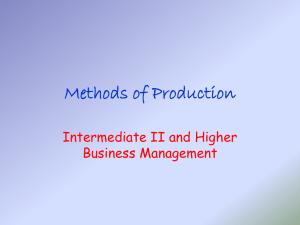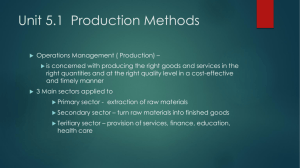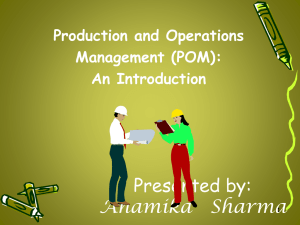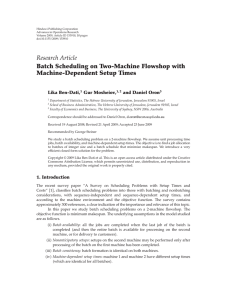5.1 - IBmgmt
advertisement
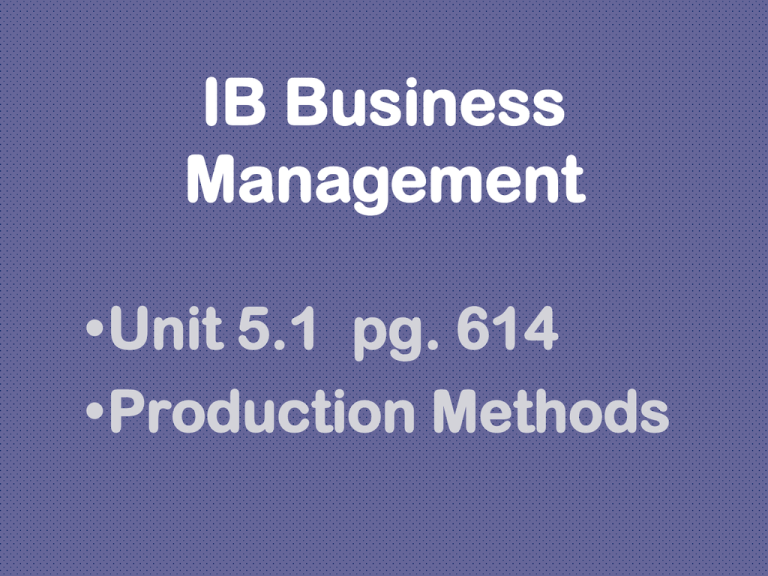
IB Business Management •Unit 5.1 pg. 614 •Production Methods Production •Referred to as operations management •Concerned with producing the right goods/services in the right quantities in a timely & costeffective manner Production •Productivity is the rate at which inputs are transformed to outputs (how efficient is the business?) •The form of production that a manager chooses will help determine a firm’s productivity Production Sectors Primary sector: extracting raw materials, harvesting crops, rearing animals (mining, agriculture, fishing) Production Sectors Secondary sector: turning natural resources into finished goods (steel production, car manufacturing) Production Sectors Tertiary sector: providing services (finance, insurance, health care, education) 4 Factors of Production • Land, labor, capital, enterprise – Known to production managers as Five M’s: materials, manpower, machines, money, mgmt • These factors are combined in costeffective way to ensure value-added is performed during ‘production’ – The value of outputs (products) is greater than the inputs (PROFIT) Production • What is the best production method for businesses? • What is best for one business may not be best for another • The same kind of product can be produced using different methods • 3 types of production: – job, batch, mass Methods of Production Job production: business creates individual product from start to finish to meet customer’s standards •Items are “tailor-made” •Usually used by small firms •No economies of scale •Examples: Custom computers, haircut, custom home, office building, Disneyland Advantages of Job Production •Quality: highly-skilled labor is used •Motivation: workers feel proud of finished product •Uniqueness: adds value to the production process •Flexibility: each product can be altered to the customer’s request Disadvantages of Job Production • Expensive: labor-intensive. • Higher cost for consumer • Time consuming • Few economies of scale • b/c each product is unique (show Ace of Cakes clips) http://www.foodnetwork.com/ace-of-cakes2/video/index.html Methods of Production Batch production: producing a limited number of identical products • One batch completed before production switches to next batch • Good for businesses that make a range of products • Example: Nike produces batches of different sizes/colors, Krispy Kreme makes batches of different doughnut types Advantages of Batch Production • Economies of scale: machines can produce larger quantities • Specialization in production process • Variety • EX: b-day cakes made in batch but can be customized Disadvantages of Batch Production •Inflexible: once a batch is started, it’s difficult to stop •Storage costs of larger quantities •Worker boredom Methods of Production Flow production: form of mass production where different operations are progressively carried out in sequence • When one task is complete, the next stage must start immediately • Ex: bottled water Methods of Production Line production: form of mass production where the product is assembled along a conveyer belt •Also known as an assembly line •Ex: vehicle manufacturers Methods of Production Mass production: producing mass amounts of standardized products • Identical products are produced in large quantities • Ex: New York Times prints one million newspapers Advantages of mass production • High volume produced at low cost (economies of scale) • Reduces average fixed costs (bc so many products are produced) • Machines can work 24 hours a day • Product quality is standardized; low defect rate • Low labor costs for unskilled workers Disadvantages of mass production • Work is boring & monotonous • Machine breakdowns cause major problems • Little flexibility in production methods • Once a process has begun, cannot make changes • Cannot tailor make to customer’s wishes • Huge set-up costs. (Must buy machines, maintenance, replacement) • Effective storage system needed Labor and Capital Intensity • Some methods of production are labor intensive while others are capital intensive • Labor intensive: – Job production, services – Used in highly skilled professions, ie lawyers – More personalization • Capital intensive: – Batch, mass production – Disadvantage: product are highly homogenous, high fixed costs Review Assignment Choose the most appropriate method of production (job, batch or mass) for each of the following and justify your answer: •iPods •Coca-Cola •Cookies •Navy battleships •42” plasma TVs •Custom suits
